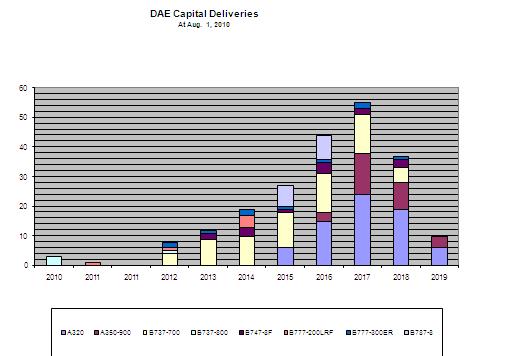Leeham News and Analysis
There's more to real news than a news release.
O’Keefe fate unknown; assessing impact on tanker competition
The fate of Sean O’Keefe, CEO of EADS North America, who was among those on the de Havilland DHC-3 Otter than crashed and killed five of the nine people on board, remains unknown. Former Alaska Sen. Ted Stevens, for whom O’Keefe once worked, was killed, according to NBC and CBS news.
O’Keefe reportedly was traveling with his son. The elder O’Keefe often accompanied Stevens on fishing trips.
EADS NA is in a controversial and bitter competition with The Boeing Co. to win the contract for the KC-X USAF aerial tanker. Whether O’Keefe was among those killed or serious injuries require a long recovery period, his absence from the EADS leadership is unlikely to affect the company’s effort to win the contract.
DAE cancels Boeing, Airbus orders
DAE Capital canceled 10 Boeing 777s, 15 Boeing 787s, and 25 A320s/A350s, according to data from both manufactures.
Commercial Aviation Online picked up the Airbus cancellations:
Dubai Aerospace Entreprise (DAE) has cancelled a total of 25 Airbus A320/A350 aircraft, latest figures from the the European manufacturer show.
The lessor, which had 70 A320 and 30 A350-900 aircraft on order, now has 52 A320 and 23 A350-900 orderbook with Airbus.
The chart above, based on the Ascend data base, shows the delivery streams for all the Airbus and Boeing orders prior to cancellation.
Boeing’s Albaugh talks about 737 future
Here is another segment of our interview with Jim Albaugh, president of Boeing Commercial Airplanes, during the Farnborough Air Show.
In this post, we report Albaugh’s thoughts on boosting the 737 rate to 40 per month and the challenges associated with doing so; the chess game between Airbus and Boeing over re-engining vs. replacement; the prospect of using an open rotor engine; and more.
Buying Russian for US lift
We have, from time-to-time, joked that the USAF ought to buy a Russian aerial tanker as a way to avoid the Boeing-EADS-Northrop-Airbus rhubarb in the long-running KC-X saga.
Well, here’s news that the US Navy is planning to buy Russian helicopters and United Technology’s Sikorsky helicopter division is not at all happy with this sole-source selection.
Let’s see if all the Buy American crowd gets as wound up over this one as they have in the KC-X contest.
Tanker award to slip to 2011?
Update, Aug. 6: Here is a Pentagon spokesman reacting to the US Aerospace protest over being rejected for its KC-X bid because it missed the filing deadline by five minutes, as reported by The Dayton Business Journal:
In a press briefing Thursday, Pentagon Press Secretary Geoff Morrell said the notion that any U.S. Military personnel deliberately interfered with the company’s attempt to deliver a bid is “absolutely absurd.”
“Listen, the other two companies that bid on this went to great measures to ensure that their bid arrived at the prescribed time … This is not a high school homework assignment, okay? These deadlines count and any professional contractor understands that,” Morrell said.
Update, August 4: This falls into the Holy Crap, What’s Next? department. The Seattle PI has the latest in the saga of the KC-X procurement. US Aerospace–the one with the Russian tanker proposal based on a plane that doesn’t exist–has filed a protest with the GAO over being denied the right to bid on the contest on a technicality.
Original Post:
In what has become perhaps the longest-running and certainly most tiresome story in Defense procurement, there is increasing speculation that the USAF contract award for the KC-X tanker might slip from November 12 into 2011.
Heidi Wood, the aerospace analyst for Morgan Stanley, wrote in her report on Boeing earnings last week that the award might slip. She did not elaborate in her note, but in an email to us expressed her skepticism of the November 12 date, given the history of this procurement.
Boeing wide-open on 777 future: Albaugh
Update, Aug. 1: Dominic Gates of The Seattle Times has a long article with the views on the 777 successor from Tim Clark, CEO of Emirates Airlines–which operates more 777s than any other airlines.
Original Post:
Boeing has a wide-open mind about how to meet the competition coming from the Airbus 350-1000 to its 777-300ER, says Jim Albaugh, president of Boeing Commercial Airplanes.
The possibilities include and entirely new aircraft; re-winging the -300ER; putting new engines on; and putting a composite fuselage on the airplane.
The latter point is a bit of an eyebrow-raiser. Reskinning the 777 would be a massive undertaking and essentially amount to an entirely new airplane.
Farnborough: Odds and Ends
Best One-Liner:
Airbus’ John Leahy is famous for his witty one-liners, but the best one at the show goes to Boeing’s Randy Tinseth. As we were waiting for the Boeing press briefing to begin on Day 1, we remarked how dirty the Airbus A380 test plane was. A regular at air shows, the plane was parked right outside the media center. It clearly hadn’t been scrubbed down for looks, with dirt streaks all over the fuselage. The logos of the A380 customers at the front of the airplane were equally covered in dirt. It stood in sharp contrast to the new Boeing 787 parked just yards away from the A380, in its shiney white paint.
Said Tinseth, virtually giggling: “They don’t wash it because they’re afraid one of the logos will come off,” suggesting a cancellation. “And you can quote me on that.”
We told the story to one of Airbus’ top PR people, who grudgenly acknowleged it was a great line. No slouch himself, he retorted the 787 was so clean because it hasn’t flown much.


